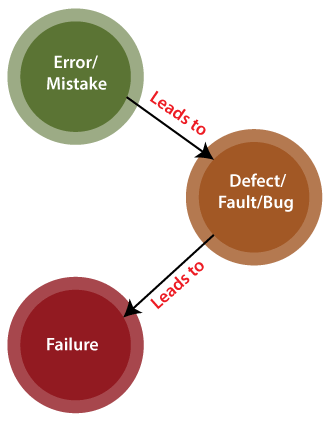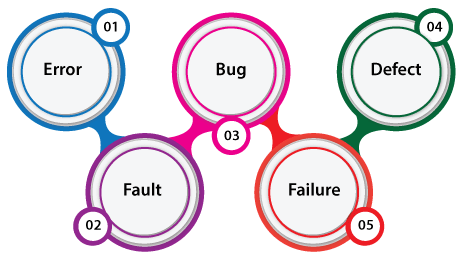In this section, we are going to discuss the difference between the Bug, Defect, Error, Fault & Failure as we understood that all the terms are used whenever the system or an application act abnormally.
Sometimes we call it an error and sometimes a bug or a defect and so on. In software testing, many of the new test engineers have confusion in using these terminologies.
Generally, we used these terms in the Software Development Life Cycle (SDLC) based on the phases. But there is a conflict in the usage of these terms.
In other words, we can say that in the era of software testing, the terms bugs, defects, error, fault, and failure come across every second of the day.
But for a beginner or the inexperienced in this field, all these terminologies may seem synonyms. It became essential to understand each of these terms independently if the software doesn't work as expected.
What is a bug?
In software testing, a bug is the informal name of defects, which means that software or application is not working as per the requirement. When we have some coding error, it leads a program to its breakdown, which is known as a bug. The test engineers use the terminology Bug.
If a QA (Quality Analyst) detect a bug, they can reproduce the bug and record it with the help of the bug report template.
What is a Defect?
When the application is not working as per the requirement is knows as defects. It is specified as the aberration from the actual and expected result of the application or software.
In other words, we can say that the bug announced by the programmer and inside the code is called a Defect.
What is Error?
The Problem in code leads to errors, which means that a mistake can occur due to the developer's coding error as the developer misunderstood the requirement or the requirement was not defined correctly. The developers use the term error.

What is Fault?
The fault may occur in software because it has not added the code for fault tolerance, making an application act up.
A fault may happen in a program because of the following reasons:
- Lack of resources
- An invalid step
- Inappropriate data definition
What is Failure?
Many defects lead to the software's failure, which means that a loss specifies a fatal issue in software/ application or in its module, which makes the system unresponsive or broken.
In other words, we can say that if an end-user detects an issue in the product, then that particular issue is called a failure.
Possibilities are there one defect that might lead to one failure or several failures.
For example, in a bank application if the Amount Transfer module is not working for end-users when the end-user tries to transfer money, submit button is not working. Hence, this is a failure.
The flow of the above terminologies are shown in the following image:

Bug Vs. Defect Vs. Error Vs. Fault Vs. Failure
We have listed some of the vital differences between bug, defect, error, fault, and failure in the below table.
|
Comparison basis |
Bug |
Defect |
Error |
Fault |
Failure |
|
Definition |
It is an informal
name specified to the defect. |
The Defect is
the difference between the actual outcomes and expected outputs. |
An Error is
a mistake made in the code; that's why we cannot execute or compile code. |
The Fault is
a state that causes the software to fail to accomplish its essential
function. |
If the software has
lots of defects, it leads to failure or causes failure. |
|
Raised
by |
The Test
Engineers submit the bug. |
The Testers identify
the defect. And it was also solved by the developer in the development phase
or stage. |
The Developers
and automation test engineers raise the error. |
Human
mistakes cause fault. |
The failure finds by
the manual test engineer through the development cycle. |
|
Different
types |
Different type of
bugs are as follows:
|
Different type of
Defects are as follows:
And based on the
severity:
|
Different type of
Error is as below:
|
Different type of
Fault are as follows:
|
----- |
|
Reasons
behind |
Following are
reasons which may cause the bugs: |
The below reason
leads to the defects: |
The reasons for
having an error are as follows: |
The reasons behind
the fault are as follows: |
Following are some
of the most important reasons behind the failure: |
|
Way
to prevent the reasons |
Following are the
way to stop the bugs: |
With the help of the
following, we can prevent the Defects: Implementing several
innovative programming methods. |
Below are ways to
prevent the Errors: |
The fault can
be prevented with the help of the following: |
The way to
prevent failure are as follows: |
Conclusion
After seeing all the significant differences between bug,
defect, error, fault, and failure, we can say that the several issues and
inconsistencies found throughout software are linked and dependent on each
other.
All the above terminology affects and change different parts of
the software and differ from one another massively. However, all these
differences between bug, defect, errors, faults, and failures slow
down the software's excellence and performance.



0 Comments